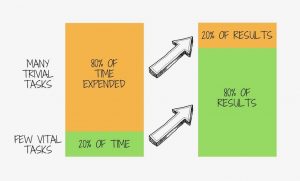
For many, a New Year brings new ideas, new wishes and renewed hope. Maybe you’ve thought about getting organized but haven’t acted on it.
Getting organized takes some courage. The courage to take actions that result in change. It may take many steps – baby steps. But every step counts!!
Maybe you’ve had nagging thoughts. These thoughts become annoying or stressful. They sound like:

Sound familiar?
Let me help you imagine what can follow next.
First, you recognize that you’re having these thoughts. Being conscious causes awareness in the present. You are very Present! This is the first baby step you take.
You realize you want support. You take time to find the “right ” person who will help you get the job done. You inquire by asking others, searching the internet, or hiring a Professional Organizer – more baby steps.
Each baby step demonstrates your courage and adds up.
Even though it feels uncomfortable, you finally decide to reveal the secrets and feelings that are challenging – with courage.
You clear time in your busy schedule and make appointments to organize. You work hand in hand at the scheduled appointment, staying open to guidance and suggestions. You make decisions during the session, and even surprise yourself! Purging items you never thought you could, or would. You let the items go, out of your possession. Some that same day!
At this point you feel pleased with your progress, and the results from your hard work. You experience a sense of accomplishment, freedom, aliveness, motivation, peace. You commit to more work days and see a clearer space and vision for yourself.

All the baby steps have accumulated to cause a personal transformation – within yourself and your space!
Congratulate yourself, it doesn’t matter how long or what it took to get to this point. Take a moment, breathe, and BE. You have earned it!
Who likes change and welcomes it? Most of us fear the unknown, even avoid it. Well, getting organized is a process of change. And, as growth is a byproduct of change, by embracing this change you are embarking into new possibilities of growth. Remember, with every step of the process, change occurs externally and internally.
“Change always comes bearing gifts” Price Pritchett
This year’s Philadelphia Home Show has a theme of “Small Spaces”. With the recent trend of Tiny Homes, this theme seems a perfect fit. Besides, many residents of Philadelphia and its surrounding areas, without ever opting into the Tiny Home movement, have been faced with the challenges of tight spaces for decades.
At the show, visitors will get a chance to browse the latest home design concepts and  products. They can also get professional home improvement tips from presenters like Tyler Wisler from HGTV’s Design Star and Kevin O’Connor of This Old House. And, if that’s not reason enough to weather the cold, I will be joining several of my fellow Productivity & Organizing Professionals (NAPO) who will also be sharing their own tips, tricks and secrets for managing your spaces and living a clutter-free life.
products. They can also get professional home improvement tips from presenters like Tyler Wisler from HGTV’s Design Star and Kevin O’Connor of This Old House. And, if that’s not reason enough to weather the cold, I will be joining several of my fellow Productivity & Organizing Professionals (NAPO) who will also be sharing their own tips, tricks and secrets for managing your spaces and living a clutter-free life.
When it comes to busy lives and challenging spaces, organization and creativity are key. The more you are able to implement systems that address the challenges of your cramped space, the more freedom and control you will begin to feel. Imagine yourself having all your supplies neatly arranged and tidily stored so that there is no searching, digging, shuffling or juggling – each time you need them. Think of how quickly and easily you could come and go, with nary a look back, confident that all you are walking away from is in order. Ahhhh, the peace of it.
However, like the physical foundations our homes are built upon, a free and organized life needs a foundation in order to be sustainable. Sometimes this means adding organizational products in order to create a “home” for the items we use. Sometimes it means removing unnecessary excess from the environment. And, it almost always means having a set of basic foundational rules in place so that patterns can be formed and replicated.
So come on out! View the new trends and home solutions, attend a presentation or two and bring your own unique organizing challenge to an “Ask the Organizer” session to get personalized advice from a NAPO-GPC professional organizer!
WHEN: JANUARY 12–15 & 19-21, 2018
WHERE: PENNSYLVANIA CONVENTION CENTER, PHILADELPHIA, PA
January is a time of beginnings – new year, new resolutions, new choices. Make 2018 YOUR year to conquer clutter chaos and gain control of your house!
I define clutter as anything that takes up space without serving any real purpose in your life. That simple statement helps my clients decide what to keep or let go. Clutter looks and feels different to everyone. It causes stress and a somewhat-to-completely-overwhelming, chaotic and sometimes unhealthy environment. It’s a daily negative reminder, conscious or unconscious, of tasks left undone.
Over time, storage areas like closets, basements and garages become stuffed. Therefore, things that should be in storage areas overtake living spaces. There are personal costs like stress, time wasted searching for things and money wasted rebuying things you can’t find or forgot you have.
It’s time to reclaim your space. Start with decluttering.
Decluttering is just the first step before organizing takes place. To be organized, among other things you need a strategy as to where everything that remains will be placed, systems that work for you, organizing principles and new habits, all of which work with your situation, personality and preferences, and maintenance techniques.
Some people are held hostage by their stuff. They hold on to things long after they’ve outlived their usefulness due to sentimental reasons, packrat tendencies, monetary value, so-and-so gave it to them or “I might need it someday.” Unused things displace things that are used.
Some of my clients have 30-year-old wedding presents in dusty, never-opened boxes on basement shelves. I ask, “WIll you use it.” “No.” “Do you like it?” “No.” “Can you get rid of it?” “No.”
As an organizing consultant, I know it’s not about just getting rid of things. It’s about the person, not the stuff. Often there are underlying psychological reasons. I dig deeper to help my clients understand WHY they’re keeping unwanted stuff. I offer safe ways to let go without losing connections to things.
Once clutter is conquered, calm replaces chaos and your home reflects how you want to live. Sound amazing? It is! Contact a professional organizer if you’d like help.
 Have you ever gotten to the end of your day wondering what (if anything) of value you actually accomplished? If so, it may be time to pull out the 80/20 Rule!
Have you ever gotten to the end of your day wondering what (if anything) of value you actually accomplished? If so, it may be time to pull out the 80/20 Rule!
Professional organizers often apply the 80/20 Rule (a.k.a., the Pareto Principle or the Law of the Vital Few) to decluttering. For example, in a closet, determine the 20% of clothes you wear 80% of the time, purge the 80% of clothes you seldom or never use, and – voila! – you have space for clothes more like your favorite few.
The principle also applies to time. Most of us accomplish 80% of our best work in just 20% of our time, and fritter away 80% of our time doing…what? The key to really accomplishing our goals, to really making an impact, is to focus on the 20% of things we are really good at.
Determining our best 20% when it comes to clothes is pretty straightforward: pull everything out of the closet and start sorting: things I love (or not), things that fit (or not), things that make me look great (or not), etc.
But how do we determine our best 20% when it comes to work? Claire Diaz-Ortiz, in the book Design Your Day, suggests this similar pull-out-and-sort activity to find out:
First, get two pieces of paper. At the top of one write “Big Wins” and on the other write “Activities.”
On the “Big Wins” paper, list things that you’ve done in the past few years, personally or professionally, that have brought you the greatest joy, that have made you feel most alive, that have made you feel like you were in the sweetest of sweet spots. These could be things that happened just once, or continuing things.
On the “Activities” paper, list absolutely everything you do on a regular basis – fun or not fun, significant or not significant, necessary or unnecessary, whatever. Then sort these items into three categories: Things Only I Can Do, Things Someone Else Can Do, and Things I Should Stop Doing. (It might help to rewrite your activities on a fresh piece of paper with three columns headed with these categories.)
Next, cross-check. Things that appear on both your “Big Wins” list and your “Things Only I Can Do” list are your best 20%!
Now, set priorities:
As Diaz-Ortiz says, “ultimately, this activity is a mind-opening way to see where your time and work is really moving the needle and where you’re just running on the hamster wheel to stay busy.”
Let 2018 be the year where you focus on the few vital tasks that best get you to where you want to be.
80/20 your 2018!
One of many things I love about the holidays is that it brings family, friends and people together. I’m appreciative of all that I’m blessed with and love blessing others. My most favorite is spending time with those I love and cherish. We hosted Thanksgiving at our home this year. We stood in a circle and talked about what we are grateful for and the importance of leaving a legacy for our young generation.
Every year we adopt a family in need. It’s so exciting to see their smiling faces filled with gratitude. I tend to notice people are more kind and friendly during the holiday season. Wouldn’t it be nice if we can stretch that kindness all year round?
This year I decided to be a little more creative with gift giving. When giving a gift I think it’s really important to know something about the person you are giving the gift to. For example, their favorite color, books they read, tech/kitchen gadgets, journal books, spas or help organize a particular space in their home.
One of my favorite things to do is create a beautiful tablescape. This year I’m creating a beautiful table scape for my sister and best friend. They are so elated. The best part is that I’m using items they already have and gifting the other items. Sometimes it’s the simplest things that people appreciate and love.
Hope your holidays are filled with love, joy and peace. Be Creative. Be Grateful. Be Kind.
The holidays are upon us! There’s so much to keep track of and so many things to do! How can this wonderfully busy time of year feel less stressful? Make a list! Or several!
I love lists! Just the act of writing a list helps me to feel like I have a clearer direction. A checklist is a concrete tool to help you empty your brain of all the things you need to remember…and then to prioritize them.
There are even more things to do and to remember than usual. I use different lists for each facet of the holidays.
If you like writing lists out on paper, keep one folder or notebook as a central location to record your plans. If you prefer going paperless, keeping documents stored on a computer or in a note-keeping system like Evernote is a convenient way to keep an ongoing record over the years.
The following are types of lists to help you stay better ordered as the activities and tasks fill your schedule:
Menus: Write out a list of the entire meal from appetizers through desserts, including those items being provided by other guests. That way, you have a comprehensive overview of the full meal and can fill in the gaps if there are any. Don’t forget to include drinks, paper products, flowers and table centerpieces.
Shopping list: Go through all the recipes you will be preparing and write out every ingredient into a grocery list. The key here is to write the food items according to sections in the grocery store. It helps dramatically when your list is ordered so you don’t have to revisit different sections of the crowded store.
Tasks: Write out all individual tasks required to prepare for the holidays so you can clearly see the extra demands on your time such as: cleaning the house, decorating, shopping for gifts, wrapping, and mailing gifts (by a designated date).
Holiday cards: Keep a master address list that you can update each year. Many people keep it in a format on their computer to print address labels. I like to sort names according to groups: family, friends, neighbors, co-workers, etc.
Gifts: Keep a list of all gifts you plan to purchase according to each person. In the margin, record the store or online vendor and price. You can plan your shopping route according to the stores listed.
Accessory shopping: While shopping for gifts, there are often other details easily overlooked. Designate a master list for details. For example, as you decorate your house or plan your holiday party, keep one list for all those particulars such as a replacement string of lights, a new set of holiday placemats, etc.
A Final Step
Your Calendar: Look through your lists regularly and write tasks into dates on your calendar in order to keep track of what is being accomplished. Write in your planner in pencil to make easy alterations or use an online calendar to easily move tasks around.
Remember: this is a busy time of year. Everything takes longer than expected. In the end, we may need to let go of a few tasks.
The ultimate goal is not to feel harried by the time the actual day arrives so you can enjoy the celebration with those you love!